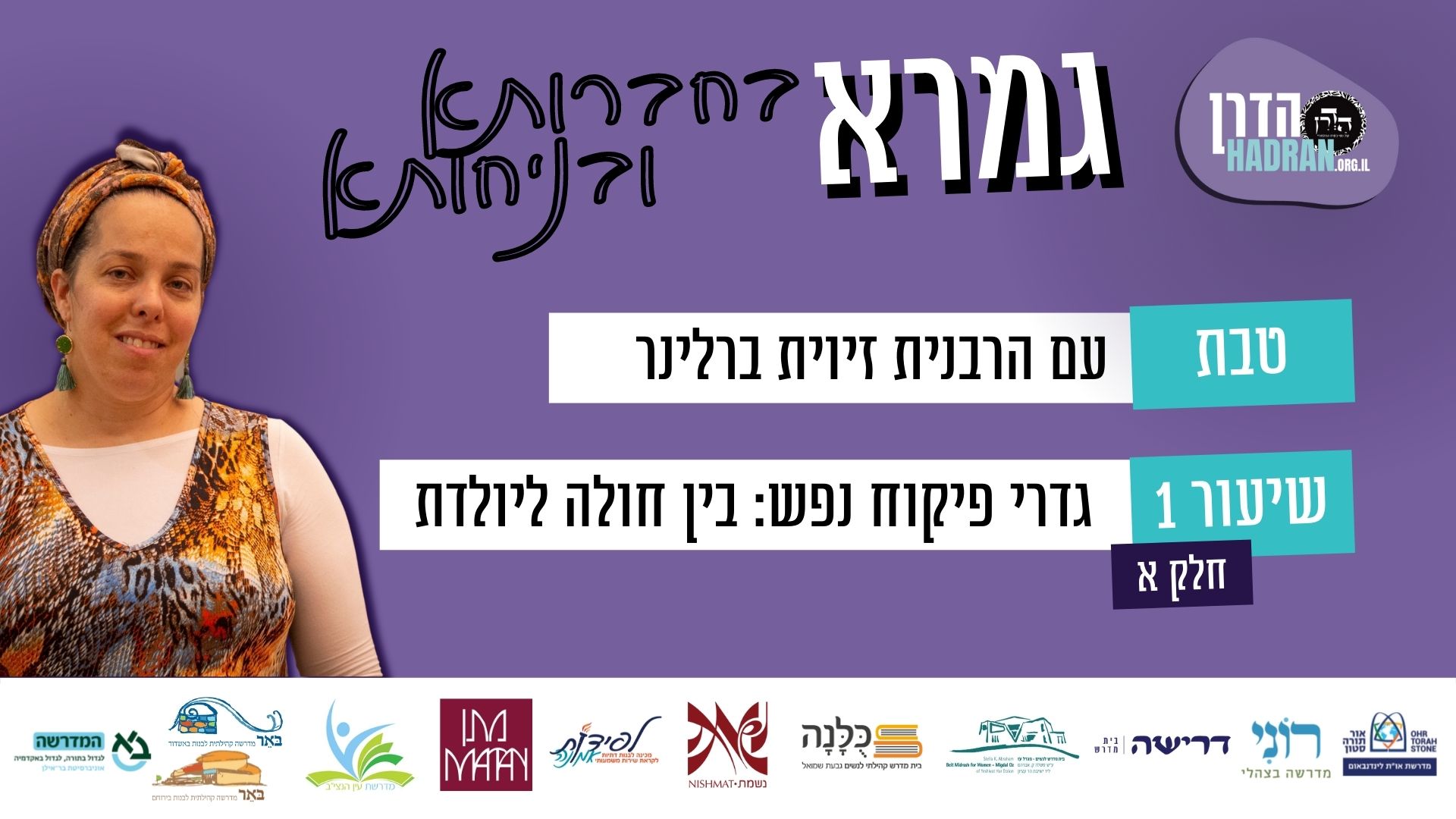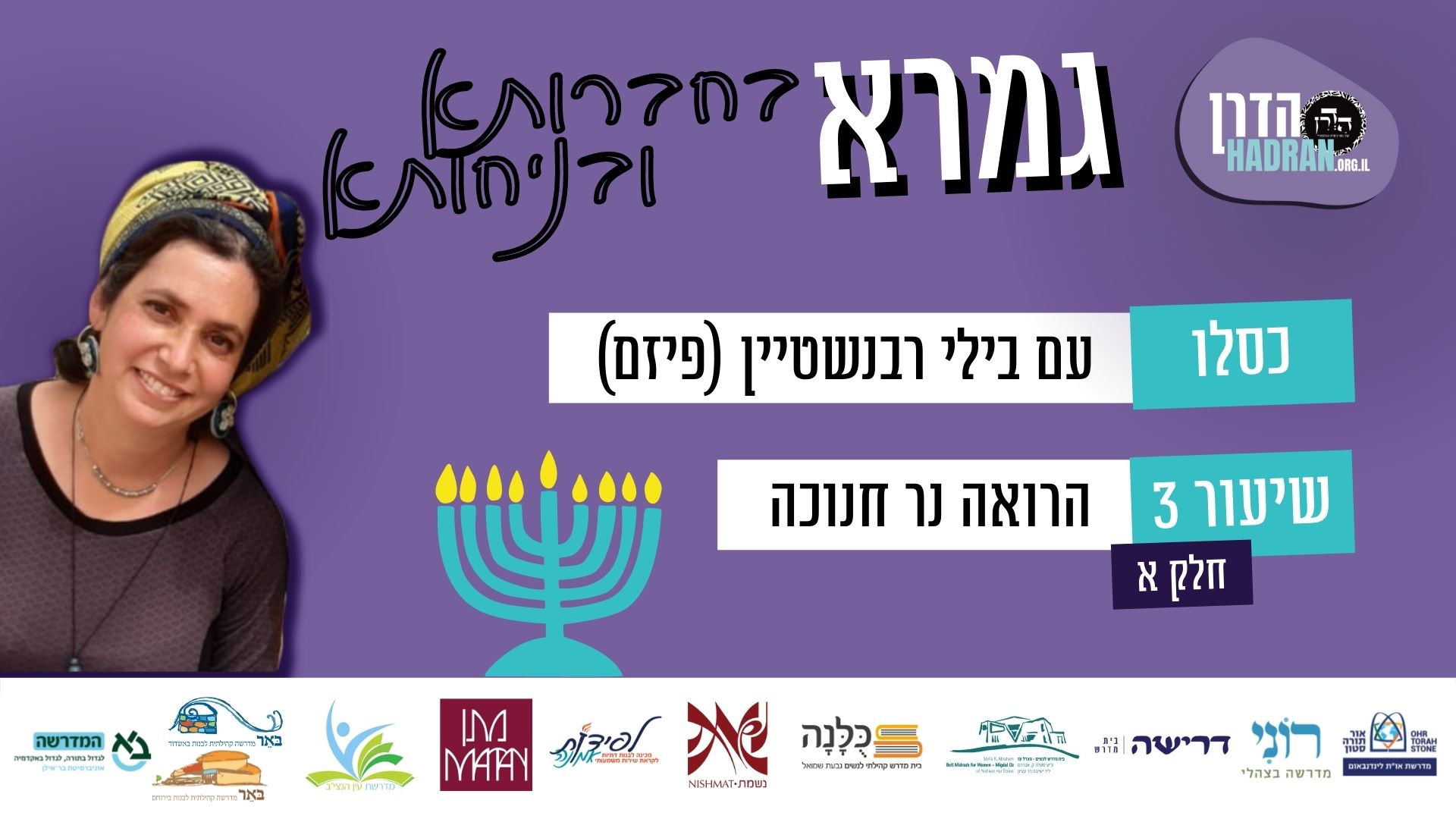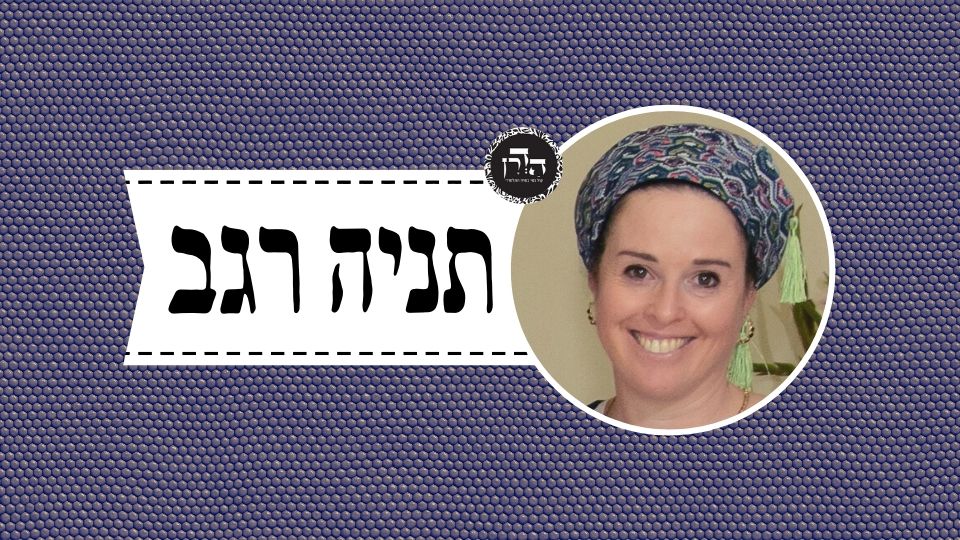שבת פג
וְרַבִּי עֲקִיבָא לְמַאי הִלְכְתָא אִיתַּקַּשׁ לְנִדָּה? — לְמַשָּׂא, לַוקְּשֵׁיהּ לִנְבֵלָה! אִין, הָכִי נָמֵי. אֶלָּא: מָה נִדָּה אֵינָהּ לְאֵבָרִין, אַף עֲבוֹדָה זָרָה אֵינָהּ לְאֵבָרִין. אֶלָּא הָא דְּבָעֵי רַב חָמָא בַּר גּוּרְיָא: עֲבוֹדָה זָרָה יֶשְׁנָהּ לְאֵבָרִים אוֹ אֵינָהּ לְאֵבָרִים — תִּיפְשׁוֹט לֵיהּ מֵהָא בֵּין לְרַבָּנַן בֵּין לְרַבִּי עֲקִיבָא דְּאֵינָהּ לְאֵבָרִים! רַב חָמָא בַּר גּוּרְיָא כְּרַבָּה מַתְנֵי, וּבָעֵי לַהּ אַלִּיבָּא דְרַבִּי עֲקִיבָא.
And according to the opinion of Rabbi Akiva, with regard to what halakha was idolatry juxtaposed to a menstruating woman? If it was to teach the halakha of impurity imparted by carrying, let it be juxtaposed to an animal carcass and not to a menstruating woman and creeping animals. The Gemara answers: Yes, it is indeed so. However, the juxtaposition to a menstruating woman teaches: Just as a menstruating woman does not transmit impurity through her limbs, as a menstruating woman who leans on an object by a single limb does not transmit impurity imparted by carrying (Ra’avad), so too, an idol does not transmit impurity through its limbs, and a section of an idol does not transmit impurity. The Gemara asks: But that which Rav Ḥama bar Guria raised as a dilemma: Does idolatry have the capacity to transmit impurity through limbs or does it not have the capacity to transmit impurity through its limbs; resolve the dilemma from this, as according to both the Rabbis and Rabbi Akiva, it does not transmit impurity through limbs. According to this explanation, Rabbi Akiva agrees with the Rabbis. The Gemara rejects this: Rav Ḥama bar Guria taught in accordance with the explanation of Rabba and raised the dilemma in accordance with the opinion of Rabbi Akiva.
מֵיתִיבִי: עֲבוֹדָה זָרָה כְּשֶׁרֶץ וּמְשַׁמְּשֶׁיהָ כְּשֶׁרֶץ. רַבִּי עֲקִיבָא אוֹמֵר: עֲבוֹדָה זָרָה כְּנִדָּה וּמְשַׁמְּשֶׁיהָ כְּשֶׁרֶץ. בִּשְׁלָמָא לְרַבִּי אֶלְעָזָר נִיחָא, אֶלָּא לְרַבָּה קַשְׁיָא! אָמַר לָךְ רַבָּה: מִי אַלִּימָא מִמַּתְנִיתִין, דְּקָתָנֵי: ״עֵצָיו וַאֲבָנָיו וַעֲפָרָיו מְטַמְּאִין כְּשֶׁרֶץ״, וְאוֹקִימְנָא, מַאי כְּשֶׁרֶץ — דְּלָא מְטַמֵּא בְּאֶבֶן מְסָמָא, הָכָא נָמֵי דְּלָא מְטַמֵּא בְּאֶבֶן מְסָמָא.
The Gemara now clarifies the explanations of Rabba and Rabbi Elazar in light of other sources. The Gemara raises an objection from that which was taught in a baraita: The ritual impurity of idolatry is like that of a creeping animal, and the ritual impurity of its accessories is like that of a creeping animal. Rabbi Akiva says: The ritual impurity of idolatry is like that of a menstruating woman, and the ritual impurity of its accessories is like that of a creeping animal. Granted, according to the opinion of Rabbi Elazar, it works out well. However, according to the opinion of Rabba, it is difficult. The dispute between Rabbi Akiva and the Rabbis in this baraita is whether idolatry is likened to a creeping animal and does not transmit impurity imparted by carrying or whether it is likened to a menstruating woman and it does transmit impurity imparted by carrying. According to Rabba, the Rabbis agree that it does transmit impurity imparted by carrying. Rabba could have said to you: Is the proof from this baraita stronger than the mishna in tractate Avoda Zara, which taught: Its wood and stones and dirt transmit impurity like a creeping animal? With regard to that mishna we established: What is the meaning of like a creeping animal? It means that it is like a creeping animal in the sense that it does not transmit impurity by means of a very heavy stone. Here too, the analogy to a creeping animal in the baraita is in the sense that it does not transmit impurity via a very heavy stone.
מֵיתִיבִי: נָכְרִי וְנׇכְרִית, עֲבוֹדָה זָרָה וּמְשַׁמְּשֶׁיהָ — הֵן וְלֹא הֶיסֵּטָן. רַבִּי עֲקִיבָא אוֹמֵר: הֵן וְהֶיסֵּטָן. בִּשְׁלָמָא לְרַבִּי אֶלְעָזָר נִיחָא, אֶלָּא לְרַבָּה קַשְׁיָא. אָמַר לָךְ רַבָּה: וְלִיטַעְמָיךְ נָכְרִי וְנׇכְרִית נָמֵי, הֵן וְלֹא הֶיסֵּטָן?! וְהָתַנְיָא: ״דַּבֵּר אֶל בְּנֵי יִשְׂרָאֵל וְגוֹ׳״ — בְּנֵי יִשְׂרָאֵל מְטַמְּאִין בְּזִיבָה וְאֵין גּוֹיִם מְטַמְּאִין בְּזִיבָה, אֲבָל גָּזְרוּ עֲלֵיהֶן שֶׁיְּהוּ כְּזָבִין לְכׇל דִּבְרֵיהֶן.
The Gemara raises an objection from what we learned: A gentile man and a gentile woman, with regard to whom the Rabbis issued a decree that they transmit impurity like a zav, idolatry and its accessories, all transmit impurity. They transmit impurity, and not their movement, i.e., they do not transmit impurity to one who moves them. Rabbi Akiva says: Both they and their movement transmit impurity. Granted, according to the explanation of Rabbi Elazar, this works out well; however, according to the explanation of Rabba, it is difficult. Rabba could have said to you: And according to your reasoning, with regard to a gentile man and a gentile woman as well, do they transmit impurity and their movement does not transmit impurity? Wasn’t it taught in a baraita with regard to the verse: “Speak to the children of Israel and say to them, when any man has an emission from his body, his emission is impure” (Leviticus 15:2), by Torah law, only the children of Israel become impure through the emission of a zav, and gentiles do not become impure through the emission of a zav? But the Sages decreed that they should be considered like a zav for all their halakhic matters. Since gentiles have the legal status of a zav, they should transmit impurity through carrying. Therefore, the baraita that states that gentiles do not transmit impurity through carrying is corrupted and must be emended.
אֶלָּא רַבָּה מְתָרֵץ לְטַעְמֵיהּ: נָכְרִי וְנׇכְרִית — הֵן וְהֶיסֵּטָן וְאֶבֶן מְסָמָא שֶׁלָּהֶן. עֲבוֹדָה זָרָה — הִיא וְהֶיסֵּטָהּ, אֲבָל לֹא אֶבֶן מְסָמָא שֶׁלָּהּ. רַבִּי עֲקִיבָא אוֹמֵר: עֲבוֹדָה זָרָה — הִיא וְהֶסֵּיטָהּ וְאֶבֶן מְסָמָא שֶׁלָּהּ. וְרַבִּי אֶלְעָזָר מְתָרֵץ לְטַעְמֵיהּ: נָכְרִי וְנׇכְרִית — הֵן וְהֶיסֵּטָן וְאֶבֶן מְסָמָא שֶׁלָּהֶן. עֲבוֹדָה זָרָה — הִיא וְלֹא הֶיסֵּטָהּ. וְרַבִּי עֲקִיבָא אוֹמֵר: עֲבוֹדָה זָרָה — הִיא וְהֶסֵּיטָהּ.
Rather, Rabba explains and adds to the baraita in accordance with his reasoning: A gentile man and a gentile woman transmit impurity, they and their movement and their very heavy stone. And idolatry transmits impurity, it and its movement but not its very heavy stone. Rabbi Akiva says: Idolatry transmits impurity, it and its movement and its very heavy stone. And Rabbi Elazar explains and adds to the baraita in accordance with his reasoning as follows: A gentile man and a gentile woman transmit impurity, they and their movement and their very heavy stone. Idolatry transmits impurity, it and not its movement. And Rabbi Akiva says: Idolatry transmits impurity, it and its movement.
מַתְקֵיף לַהּ רַב אָשֵׁי: מַאי ״הֵן״? אֶלָּא אָמַר רַב אָשֵׁי, הָכִי קָאָמַר: גּוֹי וְגוֹיָהּ, בֵּין הֵן שֶׁהֵסִיטוּ אֶת אֲחֵרִים וּבֵין אֲחֵרִים שֶׁהֵסִיטוּ אוֹתָן — טְמֵאִים. עֲבוֹדָה זָרָה שֶׁהֵסִיטָה אֲחֵרִים — טְהוֹרִין, אֲחֵרִים שֶׁהֵסִיטוּ אוֹתָהּ — טְמֵאִים. מְשַׁמְּשֶׁיהָ, בֵּין הֵן שֶׁהֵסִיטוּ אֶת אֲחֵרִים וּבֵין אֲחֵרִים שֶׁהֵסִיטוּ אוֹתָן — טְהוֹרִים. רַבִּי עֲקִיבָא אוֹמֵר: גּוֹי וְגוֹיָהּ וַעֲבוֹדָה זָרָה, בֵּין הֵן שֶׁהֵסִיטוּ אֶת אֲחֵרִים וּבֵין אֲחֵרִים שֶׁהֵסִיטוּ אוֹתָן — טְמֵאִים. מְשַׁמְּשֶׁיהָ, בֵּין הֵן שֶׁהֵסִיטוּ אֲחֵרִים וּבֵין אֲחֵרִים שֶׁהֵסִיטוּ אוֹתָן — טְהוֹרִין.
Rav Ashi strongly objects to this explanation: According to this explanation, what is the meaning of the word they in the context of this baraita? It would have been sufficient to say that their movement transmits impurity. The fact that the gentiles themselves are ritually impure is obvious. Apparently, the word they is emphasized in order to teach an additional halakha. Rather, Rav Ashi said, this is what the baraita is saying: With regard to a gentile man and a gentile woman, whether they moved others or others moved them, the others are ritually impure. The impurity of a gentile is like that of a zav, which is unique in that anything that a zav moves becomes impure even if he did not touch it directly. Idolatry that moved others, the others remain ritually pure; however, others who moved it are ritually impure. With regard to its accessories, whether they moved others or others moved them, the others remain ritually pure. Rabbi Akiva says: A gentile man and a gentile woman and idolatry, whether they moved others or others moved them, the others are ritually impure. Its accessories, whether they moved others or others moved them, the others remain ritually pure. According to this explanation, both the word they and the word movement, both of which appear in the baraita, are significant.
עֲבוֹדָה זָרָה, בִּשְׁלָמָא אֲחֵרִים שֶׁהֵסִיטוּ אוֹתָהּ — מַשְׁכַּחַתְּ לַהּ. אֶלָּא הִיא שֶׁהֵסִיטָה אֶת אֲחֵרִים הֵיכִי מַשְׁכַּחַתְּ לַהּ? אָמַר רָמֵי בְּרֵיהּ דְּרַב יֵיבָא, כְּדִתְנַן: הַזָּב בְּכַף מֹאזְנַיִם, וָאוֹכָלִין וּמַשְׁקִין בְּכַף שְׁנִיָּיה, כָּרַע הַזָּב — טְמֵאִין,
Rav Ashi’s explanation explains the baraita, but the Gemara questions the matter itself. With regard to idolatry, granted, a case where others moved it can be easily found. However, a case where the idolatry moved others, under what circumstances can it be found? How can an idol move another object? Rami, son of Rav Yeiva, said, a case like that is possible, as we learned in a mishna: In a case where the zav sat on one pan of a balance scale, and food and drinks were on the second pan, if the zav tipped the scales, the food and drinks on the other pan are ritually impure because the zav moved them.
כָּרְעוּ הֵן טְהוֹרִין. כְּמַאן אָזְלָא הָא דְּתַנְיָא כׇּל הַטֻּמְאוֹת הַמְּסִיטוֹת טְהוֹרוֹת, חוּץ מֵהֶיסֵּטוֹ שֶׁל זָב שֶׁלֹּא מָצִינוּ לוֹ חָבֵר בְּכׇל הַתּוֹרָה כּוּלָּהּ — לֵימָא דְּלָא כְּרַבִּי עֲקִיבָא, דְּאִי כְּרַבִּי עֲקִיבָא — אִיכָּא נָמֵי עֲבוֹדָה זָרָה! אֲפִילּוּ תֵּימָא רַבִּי עֲקִיבָא, תְּנָא זָב וְכׇל דְּדָמֵי לֵיהּ.
Even an inanimate object can move a source of impurity in that way. And if the food and drink tipped the scales, they remain ritually pure. The Gemara asks: In accordance with whose opinion is that which was taught in a baraita: All impure items that move other objects remain pure, meaning that an object does not become impure if moved by a source of impurity, except for movement by a zav, which has no counterpart in the whole Torah in its entirety? Let us say that this is not in accordance with the opinion of Rabbi Akiva, as if it were in accordance with the opinion of Rabbi Akiva, there is also the case of idolatry. In his opinion, idolatry also transmits impurity to an object by moving it. The Gemara answers: Even if you say that the baraita is in accordance with the opinion of Rabbi Akiva, teach: Zav and everything similar to it. According to Rabbi Akiva, just as a menstruating woman falls into that category, so too does an idol.
בָּעֵי רַב חָמָא בַּר גּוּרְיָא: עֲבוֹדָה זָרָה יֶשְׁנָהּ לְאֵבָרִים, אוֹ אֵינָהּ לְאֵבָרִים? הֵיכָא דְּהֶדְיוֹט יָכוֹל לְהַחֲזִירָהּ — לָא תִּיבְּעֵי לָךְ, דִּכְמַאן דִּמְחַבְּרָא דָּמֵי. כִּי תִּיבְּעֵי לָךְ הֵיכָא דְּאֵין הֶדְיוֹט יָכוֹל לְהַחֲזִירָהּ, מַאי? כֵּיוָן דְּאֵין הֶדְיוֹט יָכוֹל לְהַחֲזִירָהּ — כְּמַאן דְּמִתַּבְרָא דָּמֵי, אוֹ דִילְמָא הָא לָא מְחַסְּרָה. וְאִיכָּא דְּבָעֵי לַהּ לְהַךְ גִּיסָא: הֵיכָא דְּאֵין הֶדְיוֹט יָכוֹל לְהַחֲזִירָהּ — לָא תִּיבְּעֵי לָךְ, דִּכְמַאן דְּמִתַּבְרָא דָּמֵי, כִּי תִּבְּעֵי לָךְ הֵיכָא דְּהֶדְיוֹט יָכוֹל לְהַחֲזִירָהּ, מַאי? כֵּיוָן דְּהֶדְיוֹט יָכוֹל לְהַחֲזִירָהּ — כְּמַאן דִּמְחַבְּרָא דָּמֵי, אוֹ דִילְמָא הַשְׁתָּא מִיהַת הָא מִשַּׁלְפָא וְשַׁדְיָא, תֵּיקוּ.
The dilemma that was cited incidental to an earlier discussion is examined here in depth. Rav Ḥama bar Guria raised a dilemma: Does idolatry have the capacity to transmit impurity through limbs or does it not have the capacity to transmit impurity through limbs? The Gemara narrows the parameters of the dilemma. In a situation where a common unskilled person can restore it to its original form, do not raise the dilemma, as in that case it is certainly considered to be attached and is not considered broken. The case where you could raise the dilemma is where a common unskilled person cannot restore it to its original form. What is the ruling in that case? The two sides of the dilemma are: Do we say that since a common unskilled person cannot restore it, it is considered broken? Or perhaps we say that it is not lacking anything? Idolatry can only be nullified by breaking it in a case where, as a result, it is incomplete. And some raise this dilemma in another direction based on a different assumption: In a situation where a common unskilled person cannot restore it to its original form, do not raise the dilemma, as in that case it is certainly considered to be broken. When you could raise the dilemma is in a situation where a common unskilled person can restore it to its original form. What is the ruling in that case? The two sides of the dilemma are: Do we say that since a common unskilled person can restore it, it is considered attached? Or perhaps we say that at present, it is in pieces and permitted? No resolution was found for either version of this dilemma. Therefore, let it stand unresolved.
בָּעֵי רַב אַחָדְבוּי בַּר אַמֵּי: עֲבוֹדָה זָרָה פְּחוּתָה מִכְּזַיִת, מַהוּ? מַתְקִיף לַהּ רַב יוֹסֵף: לְמַאי? אִילֵימָא לְעִנְיַן אִיסּוּרָא, לֹא יְהֵא אֶלָּא זְבוּב בַּעַל עֶקְרוֹן. דְּתַנְיָא: ״וַיָּשִׂימוּ לָהֶם בַּעַל בְּרִית לֶאֱלֹהִים״, זֶה זְבוּב בַּעַל עֶקְרוֹן. מְלַמֵּד שֶׁכׇּל אֶחָד וְאֶחָד עֹשֶׂה דְּמוּת יִרְאָתוֹ וּמַנִּיחָהּ בְּתוֹךְ כִּיסוֹ, כֵּיוָן שֶׁזּוֹכְרָהּ מוֹצִיאָהּ מִתּוֹךְ כִּיסוֹ וּמְחַבְּקָהּ וּמְנַשְּׁקָהּ. אֶלָּא לְעִנְיַן טוּמְאָה מַאי? כֵּיוָן דְּאִיתַּקַּשׁ לְשֶׁרֶץ: מָה שֶׁרֶץ בְּכַעֲדָשָׁה, אַף עֲבוֹדָה זָרָה נָמֵי בְּכַעֲדָשָׁה. אוֹ דִילְמָא, הָא אִיתַּקַּשׁ לְמֵת: מָה מֵת בִּכְזַיִת, אַף עֲבוֹדָה זָרָה בִּכְזַיִת.
Rav Aḥadvoi bar Ami raised a dilemma: What is the halakha with regard to idolatry that is less than an olive-bulk? Rav Yosef strongly objected to this: With regard to what use was this dilemma raised? If you say it was raised with regard to the matter of the prohibition of idolatry, let it only be like Zevuv, the Baal of Ekron, which was the size and form of a fly, as it was taught in a baraita with regard to the verse: “And they made Baal Berit into their god” (Judges 8:33). The Sages said that this is referring to Zevuv, the Baal of Ekron. It teaches that each and every person made an image of his god and placed it in his pocket. When he remembered it, he removed it from his pocket and embraced and kissed it. Apparently, even idolatry the size of a fly falls under the rubric of the prohibition of idolatry. Rather, the dilemma is: What is the halakha with regard to the matter of impurity? The two sides of the dilemma are as follows: Since an idol is juxtaposed to a creeping animal, just as a creeping animal transmits impurity when it is a lentil-bulk, so too, idolatry transmits impurity when it is a lentil-bulk. Or perhaps idolatry is juxtaposed to a corpse, and just as a corpse transmits impurity only when it is at least an olive-bulk, so too, idolatry transmits impurity only when it is at least an olive-bulk.
אָמַר רַב אַוְיָא וְאִיתֵּימָא רַבָּה בַּר עוּלָּא, תָּא שְׁמַע דְּתַנְיָא: עֲבוֹדָה זָרָה פְּחוּתָה מִכְּזַיִת אֵין בָּהּ טוּמְאָה כׇּל עִיקָּר, שֶׁנֶּאֱמַר: ״וַיַּשְׁלֵךְ אֶת עֲפָרָהּ אֶל קֶבֶר בְּנֵי הָעָם״ — מָה מֵת בִּכְזַיִת, אַף עֲבוֹדָה זָרָה בִּכְזַיִת.
Rav Avya said, and some say it was Rabba bar Ulla who said: Come and hear a resolution to this dilemma from that which was taught in a baraita: Idolatry that is less than an olive-bulk has no impurity at all, as it is stated: “And he brought out the ashera from the house of the Lord, outside Jerusalem, to the brook of Kidron, and burned it at the brook of Kidron, and stamped it into powder, and cast its powder upon the graves of the common people” (II Kings 23:6). Just as a corpse transmits impurity when it is an olive-bulk, so too, idolatry transmits impurity when it is an olive-bulk.
וְרַבָּנַן, לְמַאי הִלְכְתָא אִיתַּקַּשׁ לְשֶׁרֶץ — דְּלָא מְטַמֵּא בְּמַשָּׂא, לְנִדָּה — דְּאֵינָהּ לְאֵבָרִין, לְמֵת — דְּלָא מְטַמֵּא בְּכַעֲדָשָׁה. אֵימָא לְחוּמְרָא: לְמַאי הִלְכְתָא אַקְּשַׁהּ רַחֲמָנָא לְשֶׁרֶץ — לְטַמּוֹיֵי בְּכַעֲדָשָׁה, לְנִדָּה — לְטַמּוֹיֵי בְּאֶבֶן מְסָמָא, אַקְּשַׁהּ רַחֲמָנָא לְמֵת — לְטַמּוֹיֵי בְּאֹהֶל! טוּמְאַת עֲבוֹדָה זָרָה דְּרַבָּנַן הִיא, וְקוּלָּא וְחוּמְרָא — לְקוּלָּא מַקְּשִׁינַן, לְחוּמְרָא לָא מַקְּשִׁינַן.
The Gemara now asks a general question: And according to the Rabbis, with regard to what halakha was idolatry juxtaposed to a creeping animal? The juxtaposition establishes that like a creeping animal, it does not transmit impurity through carrying. The juxtaposition to a menstruating woman establishes that like a menstruating woman, it has the capacity to transmit impurity through limbs. The juxtaposition to a corpse establishes that it does not transmit impurity when it is a lentil-bulk. The Gemara suggests: Let us say that all of these juxtapositions come to teach a stringency. With regard to what halakha did the Torah juxtapose idolatry to a creeping animal? It is to establish that it transmits impurity when it is a lentil-bulk. The juxtaposition of idolatry to a menstruating woman is to establish that it transmits impurity via a very heavy stone; and the Torah juxtaposed it to a corpse to establish that it transmits impurity imparted by a tent, all of which are stringencies that exist with regard to those types of impurity. The Gemara answers: The impurity of idolatry is by rabbinic law. And whenever there are two possibilities with regard to a rabbinic decree, a leniency and a stringency, we juxtapose to establish the lenient possibility, and we do not juxtapose to establish the stringent possibility.
מַתְנִי׳ מִנַּיִן לִסְפִינָה שֶׁהִיא טְהוֹרָה — שֶׁנֶּאֱמַר: ״דֶּרֶךְ אֳנִיָּה בְלֶב יָם״.
MISHNA: This is another mishna that digresses from the central topic of this tractate. It, too, is based on an allusion from the Bible. From where is it derived that the ship is ritually pure, in the sense that it cannot become impure? As it is stated: “The way of a ship in the midst of the sea” (Proverbs 30:19).
גְּמָ׳ פְּשִׁיטָא, אֳנִיָּה בְּלֶב יָם הִיא! הָא קָא מַשְׁמַע לַן כְּיָם: מָה יָם טָהוֹר — אַף סְפִינָה טְהוֹרָה. תַּנְיָא, חֲנַנְיָה אוֹמֵר: נִלְמְדֶנָּה מִשַּׂק, מָה שַׂק מִיטַּלְטֵל מָלֵא וְרֵיקָן — אַף כֹּל מִיטַּלְטֵל מָלֵא וְרֵיקָן. לְאַפּוֹקֵי סְפִינָה, דְּאֵינָהּ מִיטַּלְטֶלֶת מְלֵאָה.
GEMARA: The allusion in the mishna requires clarification. The verse appears to state the obvious. Of course a ship is in the midst of the sea. Rather, this verse teaches us an allusion that the legal status of a boat is like that of the sea. Just as the sea is ritually pure and cannot become impure, so too, a boat is ritually pure and cannot become impure. It was taught in a baraita that Ḥananya says: This halakha is derived from the halakha of a sack, as the impurity of wooden vessels is likened to the impurity of a sack. Just as a sack, which can become ritually impure, is carried both full and empty, so too, any object that is carried both full and empty can become ritually impure. This is to exclude a ship, which is not carried on land full and empty, as due to its weight it cannot be carried full.
מַאי בֵּינַיְיהוּ? אִיכָּא בֵּינַיְיהוּ סְפִינָה שֶׁל חֶרֶס. מַאן דְּאָמַר ״אֳנִיָּה בְּלֶב יָם״, הָא נָמֵי בְּלֶב יָם הִיא. לְמַאן דְּאָמַר כְּשַׂק — הָנָךְ הוּא דִּכְתִיבִי גַּבֵּי שַׂק, דְּאִי מִיטַּלְטֵל מָלֵא וְרֵיקָן אִין, אִי לָא — לָא. אֲבָל סְפִינָה שֶׁל חֶרֶס, אַף עַל גַּב דְּאֵינָהּ מִיטַּלְטֶלֶת מְלֵאָה.
The Gemara asks: What is the practical difference between the two reasons? The halakhic ruling according to both is that a ship cannot become impure. The Gemara explains: There is a difference between them with regard to a ship made from earthenware or from any material other than wood. According to the one who said that it is derived from the verse: “A ship in the midst of the sea,” this boat is also in the midst of the sea. However, according to the one who said that it is derived from the halakha of a sack, this halakha applies only to those materials that are written in the same verse together with sack and are likened to it. If it is carried both full and empty, yes, it can become impure; and if it can not be carried both full and empty, no, it cannot become impure. However, an earthenware ship can become impure even though it is not carried both full and empty.
אִי נָמֵי סְפִינַת הַיַּרְדֵּן. לְמַאן דְּאָמַר אֳנִיָּה בְּלֶב יָם הִיא — הָא נָמֵי אֳנִיָּה בְּלֶב יָם הִיא. לְמַאן דְּאָמַר מִיטַּלְטֶלֶת מָלֵא וְרֵיקָן — הָא נָמֵי מִיטַּלְטֶלֶת מְלֵאָה וְרֵיקָנִית. דְּאָמַר רַבִּי חֲנִינָא בֶּן עֲקַבְיָא: מִפְּנֵי מָה אָמְרוּ סְפִינַת הַיַּרְדֵּן טְמֵאָה — מִפְּנֵי שֶׁטּוֹעֲנִים אוֹתָהּ בַּיַּבָּשָׁה, וּמוֹרִידִין אוֹתָהּ לַמַּיִם. אָמַר רַב יְהוּדָה אָמַר רַב: לְעוֹלָם אַל יִמְנַע אָדָם אֶת עַצְמוֹ מִבֵּית הַמִּדְרָשׁ וַאֲפִילּוּ שָׁעָה אַחַת, שֶׁהֲרֵי כַּמָּה שָׁנִים נִשְׁנֵית מִשְׁנָה זוֹ בְּבֵית הַמִּדְרָשׁ וְלֹא נִתְגַּלָּה טַעְמָהּ עַד שֶׁבָּא רַבִּי חֲנִינָא בֶּן עֲקַבְיָא וּפֵירְשָׁהּ.
Alternatively, there is a difference between them regarding a Jordan ship, which is a small boat used on the Jordan River. According to the one who said that it is derived from the verse: “A ship in the midst of the sea,” this is also a ship in the midst of the sea. A river is pure like the sea and the boat will remain pure. According to the one who said that it is derived from the halakha of a sack, and in order to become impure it must be carried full and empty, this is also carried both full and empty, and can become ritually impure. As Rabbi Ḥanina ben Akavya said: For what reason did they say that a Jordan ship can become impure? Because they load it on dry land and carry it on land and then lower it into the water. It is carried on land when full. Rav Yehuda said that Rav said: One should never prevent himself from attending the study hall for even one moment, as this mishna which states that a Jordan ship can become ritually impure was taught for several years in the study hall, but its reason was not revealed until Rabbi Ḥanina ben Akavya came and explained it.
אָמַר רַבִּי יוֹנָתָן: לְעוֹלָם אַל יִמְנַע אָדָם אֶת עַצְמוֹ מִבֵּית הַמִּדְרָשׁ וּמִדִּבְרֵי תוֹרָה וַאֲפִילּוּ בִּשְׁעַת מִיתָה, שֶׁנֶּאֱמַר: ״זֹאת הַתּוֹרָה אָדָם כִּי יָמוּת בְּאֹהֶל״ — אֲפִילּוּ בִּשְׁעַת מִיתָה תְּהֵא עוֹסֵק בַּתּוֹרָה. אָמַר רֵישׁ לָקִישׁ: אֵין דִּבְרֵי תוֹרָה מִתְקַיְּימִין אֶלָּא בְּמִי שֶׁמֵּמִית עַצְמוֹ עָלֶיהָ, שֶׁנֶּאֱמַר: ״זֹאת הַתּוֹרָה אָדָם כִּי יָמוּת בְּאֹהֶל״. אָמַר רָבָא
Following Rav’s statement, the Gemara cites that which Rabbi Yonatan said: One should never prevent himself from attending the study hall or from engaging in matters of Torah, even at the moment of death, as it is stated: “This is the Torah: A person who dies in a tent” (Numbers 19:14). That is an allusion to the fact that even at the moment of death, one should engage in the study of Torah. Reish Lakish said: Matters of Torah only endure in a person who kills himself over the Torah, one who is ready to devote all his efforts to it, as it is stated: “This is the Torah: A person who dies in a tent,” meaning that the Torah is only attained by one who kills himself in its tent. Rava said:






































